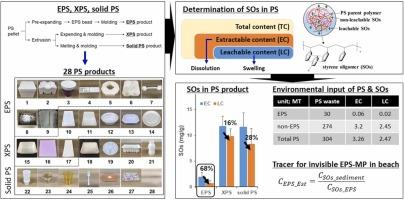Distinguishing between Extractable and Leachable Contents of Styrene Oligomers in Various Polystyrene Consumer Products: Towards Environmentally Realistic Scenarios
IF 12.2
1区 环境科学与生态学
Q1 ENGINEERING, ENVIRONMENTAL
引用次数: 0
Abstract
Plastic additives' environmental impacts remain insufficiently understood due to knowledge gaps in their bioavailability, despite growing concerns from increased plastic use and waste. Additives that are non-covalently bound but strongly interact with polymers can be extractable but not leachable, thus non-bioavailable. Nevertheless, most studies have not distinguished between extractable (EC) and leachable content (LC) in plastic additives. We quantified the EC and LC of styrene oligomers (SOs) in polystyrene (PS) by applying the selective solvent compatibility of PS—dissolution in dichloromethane for EC and swelling in n-hexane for LC. Significant differences were found between EC and LC of SOs in 28 widely consumed PS products and across three PS types—expanded PS (EPS), extruded PS (XPS), and solid PS. EPS showed lower EC and LC values and fewer SO isomers. LCs were only 32% (EPS), 84% (XPS), and 72% (solid PS) of ECs, suggesting bioavailable fractions may be overestimated if only EC is considered. We estimate that 3.3 MT of PS-incorporated SOs, with 76% in leachable forms, have entered the environment, but much may still remain in PS debris. Distinct isomer ratios and high non-leachable fractions in EPS suggest that SOs could serve as effective tracers for distinguishing and quantifying invisible EPS-origin particles in beach sediments. This study underscores the need to differentiate EC from LC for environmentally realistic risk assessment and source identification.

区分各种聚苯乙烯消费品中苯乙烯低聚物的可萃取和可浸出含量:迈向环境现实方案
尽管塑料使用和浪费的增加日益引起人们的关注,但由于对塑料添加剂生物利用度的知识差距,人们对其环境影响的了解仍然不够充分。非共价结合但与聚合物强相互作用的添加剂可提取但不可浸出,因此不可生物利用。然而,大多数研究并没有区分塑料添加剂中的可萃取(EC)和可浸(LC)含量。利用聚苯乙烯(PS)中苯乙烯低聚物(SOs)在二氯甲烷中溶解和在正己烷中溶胀的选择性溶剂相容性,定量了聚苯乙烯(PS)中苯乙烯低聚物(SOs)的EC和LC。在28种广泛消费的PS产品中,在膨化PS (EPS)、膨化PS (XPS)和固体PS (XPS)三种PS类型中,SOs的EC和LC值存在显著差异,EPS的EC和LC值较低,SO异构体较少。lc仅占ECs的32% (EPS)、84% (XPS)和72%(固体PS),这表明如果只考虑EC,生物利用度可能被高估。我们估计有330万吨含PS的SOs,其中76%为可浸出形式,已进入环境,但仍有许多可能留在PS碎片中。EPS中不同的异构体比例和高不可浸出分数表明,SOs可以作为有效的示踪剂,用于区分和量化海滩沉积物中不可见的EPS来源颗粒。这项研究强调了区分EC和LC的环境现实风险评估和来源识别的必要性。
本文章由计算机程序翻译,如有差异,请以英文原文为准。
求助全文
约1分钟内获得全文
求助全文
来源期刊

Journal of Hazardous Materials
工程技术-工程:环境
CiteScore
25.40
自引率
5.90%
发文量
3059
审稿时长
58 days
期刊介绍:
The Journal of Hazardous Materials serves as a global platform for promoting cutting-edge research in the field of Environmental Science and Engineering. Our publication features a wide range of articles, including full-length research papers, review articles, and perspectives, with the aim of enhancing our understanding of the dangers and risks associated with various materials concerning public health and the environment. It is important to note that the term "environmental contaminants" refers specifically to substances that pose hazardous effects through contamination, while excluding those that do not have such impacts on the environment or human health. Moreover, we emphasize the distinction between wastes and hazardous materials in order to provide further clarity on the scope of the journal. We have a keen interest in exploring specific compounds and microbial agents that have adverse effects on the environment.
 求助内容:
求助内容: 应助结果提醒方式:
应助结果提醒方式:


